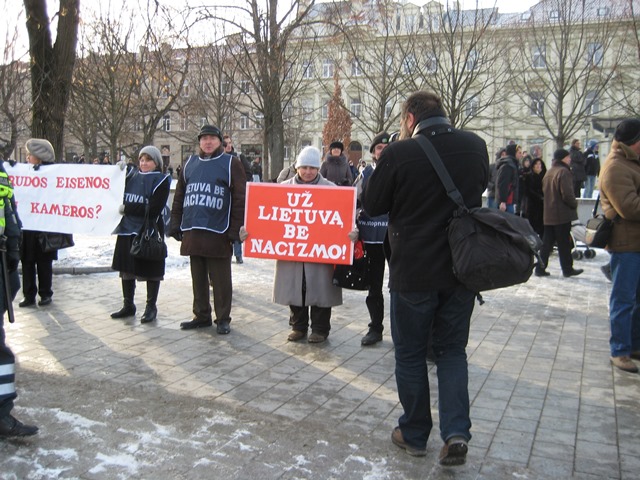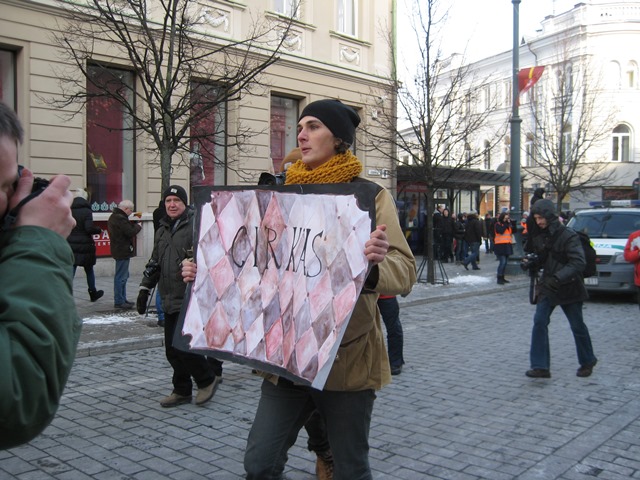E Y E W I T N E S S R E P O R T / O P I N I O N
by Anna Shepherd
Photos by Anna Shepherd; they may be reproduced with accreditation to Defending History (this page) and to Ms. Shepherd.
An unsanctioned neo-Nazi march took place today on Gedimino Boulevard, the main avenue of central Vilnius, as Lithuania celebrated its 1990 declaration of independence from the Soviet Union. It had an estimated three thousand participants, the largest number ever.
Vilnius authorities had this year issued a permit for the nationalists’ march to take place on Upės Street, a venue across the river, further from the city center. Instead of the neo-Nazi march that has occurred each year since 2008, this year Gedimino was supposed to be host of “Laisves Vejas” (Wind of Freedom), a celebration of freedom and independence including music, dance, poetry and other wholesome performances.
But after failing to receive permission to march on Gedimino, the organizers of the neo-Nazi march applied for permission to march on a route in the Old Town. However, in a press conference held on 8th of March, Vilnius Mayor Artūras Zuokas confirmed that a permit was being issued only for Upės Street and a march at any other location would be illegal. Following this decision, the organizer of the march, the Union of Nationalist Youth, hinted about the possibility of an unsanctioned march.
Julius Panka, leader of the Union of Nationalist Youth, invited people to gather in Cathedral Square at 3 PM today. In response, Vilnius police stated that they would be on alert in case of unsanctioned events, with up to 300 extra police officers patrolling the city center. Kęstutis Lančinskas, chief of Vilnius County Police Headquarters, said that any incidents would be dealt with on a case-to-case basis, and that police would be ready to seize offensive banners and record any offences.
◊
At 1 PM this Independence Day, the usual starting time of the neo-Nazi march, the center of Vilnius was calm. Quite many people had braved the cold weather to celebrate Independence Day on Gedimino, where there was an open-air photography exhibition called “Reflections of the Grand Duchy of Lithuania,” a stage for poetry readings, a children’s stage, podiums for several DJs, and a “healthy city” area where people could try out football, street basketball and other activities. A couple of people I talked to were pleased about the events that were taking place this year, stating that they were more inclusive and a welcome alternative to the neo-Nazi march.
There was heavy and visible police presence around Cathedral Square where the unsanctioned gathering was to take place.
At 3 pm people started to gather with flags, banners and armbands. According to police estimates, approximately three thousand people participated in the march, a much higher number than any previous year. The police moved in on the crowd to control (rather than halt) the situation and they checked people’s bags for dangerous objects. On Cathedral Square there were chants of Lietuva Lietuviams (“Lithuania for Lithuanians”), but when at 4 PM the march started to proceed up Gedimino Boulevard it became just Lietuva (perhaps as a legal precaution). Police cars occupied the avenue on both sides of the stalls, stages and photo exhibition stands that had been set up in the middle of the boulevard for the earlier sanctioned activities, forcing the march onto the sidewalk. But after passing the main stage at Kudirka Square, the march moved onto the road for the rest of the way, exactly as in previous years.
Leading at the front of the march I identified Petras Gražulis, member of parliament, and Julius Panka, leader of the Nationalist Youth organization. Among the march’s leaders were a group of five or six signatories of the nation’s 1990 declaration of independence; for rapid identification one of them carried a sign reading “Signatarai” (Signatories).

Sign identifying the group of five or six signatories of the 1990 declaration of independence who were at the parade’s forefront
Based on my own observations, compared to previous years there were noticeably fewer offensive banners and symbols. This could perhaps be in line with possible instructions from organizers wanting to ensure the unsanctioned march goes ahead with as few problems as possible. I did however witness some sieg heils and some of the jackets had sewn-on “Lithuanian swastika” insignia (with added lines). The march ended in Lukiškės Square, where the marchers gathered to listen to speeches and music.

The “Lithuanian swastika” worn during the march

Lithuanian swastika at upper left of skull and crossbones flag (marked by added yellow arrow) at the rally on Cathedral Square and carried throughout the march

Sieg heils are back on Gedimino
◊
A few brave and relatively small groups (totaling perhaps thirty people in all, principally in three groups) came to protest against the march. At Cathedral Square I saw a handful of people with anti-fascist signs who I was told were representatives of The Socialist People’s Front of Lithuania.

The group of protesters from the Socialist People’s Front and Lithuania Without Nazism
Also present were the Lithuanian Antifa movement and a group of anarchists. According to one of the protesters in the anarchist group, police wanted to check their banners to make sure they are not too provocative and warned them against breaking any laws. When the march started, the group was pushed to the side out of the way of the neo-Nazi marchers. After this they moved to protest on the Cathedral steps and then on Gedimino Boulevard, always protected by police who according to the protester I talked to were polite and professional.
Protests also took more individualistic forms: when the march had reached Gedimino a man walked in front of the procession holding up a sign reading “Cirkas” (A Circus!). Human rights activist Fiokla Kiure carried a sign that translates: “I’m ashamed to live in a country that’s run by Mankurts.”

Fiokla Kiure carries a sign reading: “I’m ashamed to live in a country that’s run by Mankurts.”

Sign reads: “A CIRCUS”
In front of Trip Bar at Gedimino 31, which was hosting an alternative Independence Day celebration to promote music from the upcoming film We Will Riot by young Lithuanian film director Romas Zabarauskas, organizers and participators stood on the sidewalk chanting Lietuva visiems (“Lithuania for everyone”), which provoked some marchers to attempt confrontation. However, as throughout the entire march, the police protected protestors and observers in a very professional manner.

Briton Mark Splinter (right) with Romas Zabarauskas and other protesters along Gedimino proclaim resolutely: “Lithuania for everyone!”
It was a joy to see the various groups of courageous Lithuanians standing up to the neo-Nazis and reclaiming Independence Day. In the words of the young protesters: Lietuva visiems!
More articles by Anna Shepherd
Editor’s note: See also Geoff Vasil’s report.